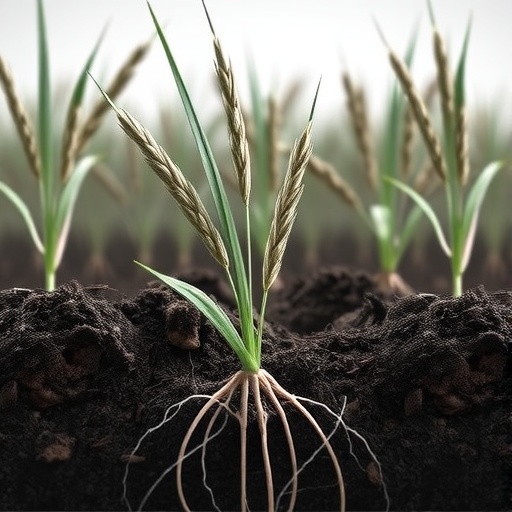In a groundbreaking study published in the esteemed journal Biochar, researchers from Hebei University of Technology have unveiled a remarkable catalytic role of nano-biochar in facilitating the natural synthesis and bioaccumulation of silver nanoparticles in rice roots. This discovery elucidates previously uncharted mechanisms by which nano-biochar, a nanostructured form of carbon, actively participates in biogeochemical transformations in the rhizosphere, the soil interface intimately associated with plant roots. The findings have significant implications for environmental chemistry, agricultural science, and nanotechnology, offering new insights into metal cycling and improving our understanding of nanoparticle formation in natural ecosystems.
Silver, a metal prized for its electrical conductivity and potent antimicrobial properties, is ubiquitously used across multiple industries, from electronics manufacturing to medical device sterilization. However, widespread industrial and consumer use results in persistent silver ion contamination in soils and aquatic environments. These ions (Ag⁺) are highly reactive and pose considerable toxicological risks to biotic communities, particularly plant and microbial populations. Despite the environmental threats posed by ionic silver, metallic silver nanoparticles exhibit enhanced stability and reduced toxicity. Until now, the exact pathways underlying the natural formation and subsequent uptake of these nanoparticles within plant systems remained obscure.
The research team, led by Shiguo Gu and Fei Lian, investigated the role of nano-biochar as an electron mediator in the rhizosphere microenvironment. Nano-biochar consists of carbonaceous nanomaterials derived from pyrolysis of biomass, possessing unique physicochemical characteristics including high surface area, abundant functional groups, and redox activity. Upon addition of nano-biochar to hydroponic systems cultivating rice plants, the team observed that nano-biochar effectively shuttled electrons from the root-released oxygen to surrounding silver ions. This electron transfer process produced reactive oxygen species, notably superoxide radicals (O2•−), which reduced silver ions into elemental silver in nanoparticulate form.
Utilizing state-of-the-art analytical techniques such as single-particle inductively coupled plasma mass spectrometry (spICP-MS) and high-resolution electron microscopy, the investigators visualized and quantified the formation and spatial distribution of Ag nanoparticles. Remarkably, nanoparticles formed not only in the rhizosphere’s immediate vicinity but were also translocated into internal plant tissues, accumulating within roots, leaves, and cellular compartments. This endogenous nanoparticle biosynthesis challenges traditional views that biochar functions solely as a passive soil amendment and positions nano-biochar as an active bio-catalyst influencing metal speciation and mobility in plants.
The researchers uncovered a nuanced dynamic where the concentration of nano-biochar dictates the extent of silver nanoparticle generation. Moderate levels of nano-biochar enhanced oxygen release from roots, thus maximizing superoxide radical production and synergizing silver reduction. Conversely, excessive nano-biochar diminished root oxygen efflux, thereby inhibiting nanoparticle formation. This biphasic response underscores the importance of dose optimization when considering nano-biochar applications for agricultural or environmental remediation purposes.
Beyond nanoparticle formation, nano-biochar exerted a protective influence by reducing total silver uptake in rice plants. This attenuation likely results from a dual mechanism: chemical conversion of toxic ionic silver to less bioavailable nanoparticles and nano-biochar’s intrinsic adsorption capabilities. Such protective modulation suggests promising avenues for employing nano-biochar to mitigate heavy metal phytotoxicity, enhancing crop resilience in contaminated soils while minimizing entry of harmful metals into the human food chain.
The study’s insights reveal that nano-biochar acts as an electron shuttle and redox mediator, catalyzing critical transformations of redox-sensitive metals like silver. This catalytic role reshapes our understanding of biogeochemical cycling in the rhizosphere, highlighting the intricate interplay between nanomaterials, plant root exudates, and metal speciation. The findings suggest that engineered biochars could be tailored to harness or modulate these processes to improve soil health and promote sustainable agriculture.
This work also prompts urgent questions regarding environmental and food safety. The bioaccumulation of metallic silver nanoparticles within edible plant tissues necessitates further toxicological studies to assess potential health risks to consumers. Moreover, understanding the fate and transport of these biogenic nanoparticles in soil and water ecosystems is paramount. As natural nanoparticles emerge as pervasive environmental constituents, their ecological ramifications require comprehensive evaluation.
Scientifically, this research paves the way for innovative uses of nano-biochar in environmental management. By leveraging its electron transfer capabilities and metal-reducing properties, nano-biochar could be developed as a novel remediation strategy to immobilize toxic metals or recycle valuable elements in polluted environments. Furthermore, optimizing nano-biochar applications could enhance nutrient bioavailability and stimulate beneficial microbial communities, synergistically advancing soil fertility.
In summary, the discovery of nano-biochar’s active catalytic function in silver nanoparticle genesis and accumulation fundamentally extends the paradigm of biochar’s role in the soil-plant continuum. The integration of advanced nanometrology techniques with plant biology elucidates complex redox interactions that occur at the nano-biochar-root interface, offering transformative potential for sustainable environmental and agricultural science. As industries and ecosystems grapple with metal contamination, nano-biochar emerges as a double-edged sword—both a facilitator of nanoparticle formation and a guardian against metal toxicity—whose precise management will be key to future advances.
Subject of Research: Not applicable
Article Title: Insight into the crucial role of nano-biochar in the natural formation and bioaccumulation of silver nanoparticles in the rhizosphere by single-particle ICP-MS
News Publication Date: 16-Sep-2025
References:
Gu, S., Sun, B., Wang, F. et al. Insight into the crucial role of nano-biochar in the natural formation and bioaccumulation of silver nanoparticles in the rhizosphere by single-particle ICP-MS. Biochar 7, 111 (2025). DOI: 10.1007/s42773-025-00492-w
Image Credits: Shiguo Gu, Binbin Sun, Fei Wang, Wei Zhu, Fei Lian & Jie Li
Keywords
Nanomaterials, Nanoparticles, Soil chemistry
Tags: agricultural applications of nanotechnologybiogeochemical transformations in rhizospherebiotic communities and silver toxicityenhancing crop resilience with nano-materialsenvironmental chemistry of metalsnano-biochar in agriculturenatural nanoparticle formation in ecosystemssilver ion detoxification in plantssoil and plant interactionssustainable farming practicessynthesis of silver nanoparticlestoxic effects of silver ions





